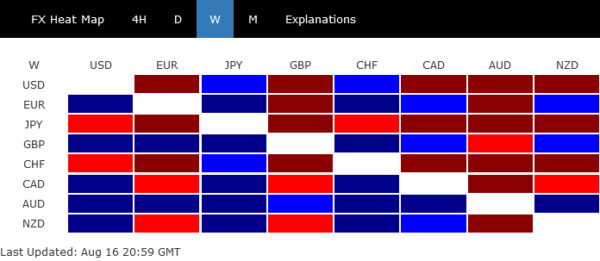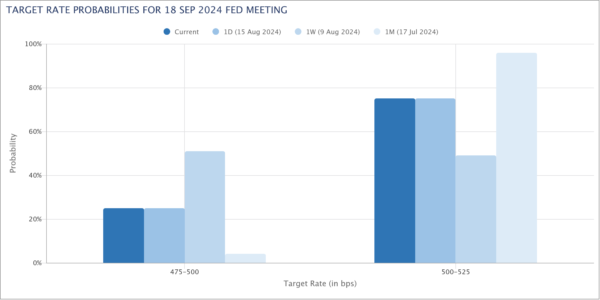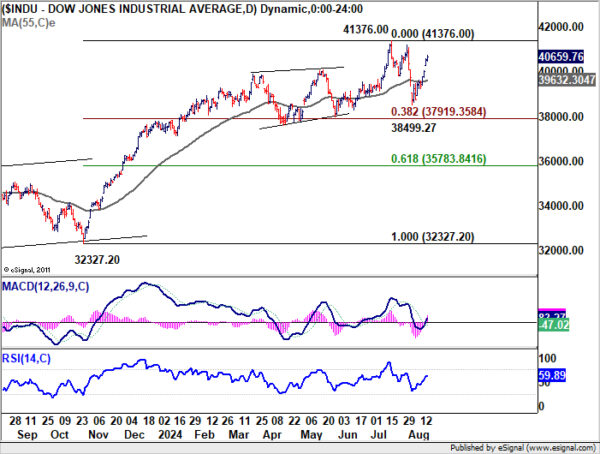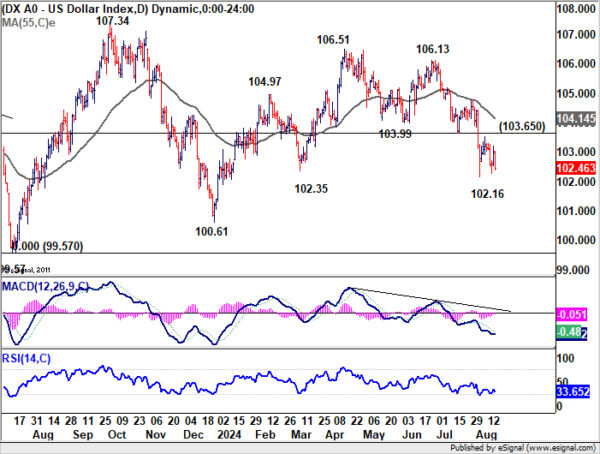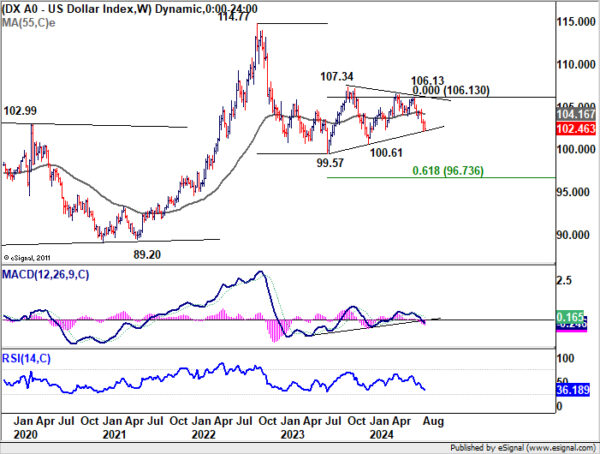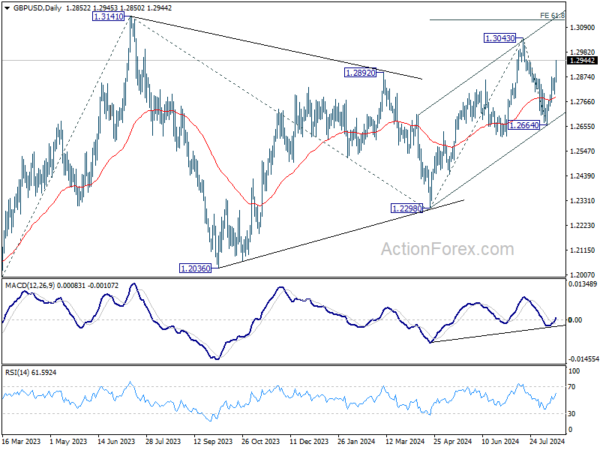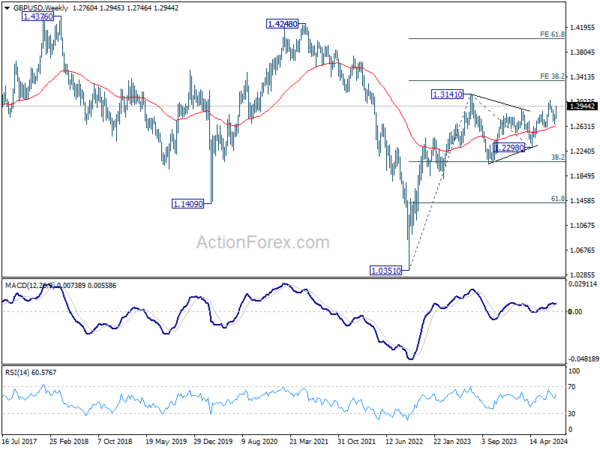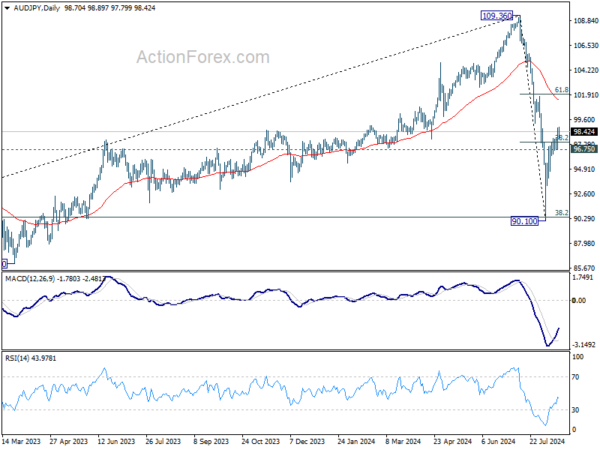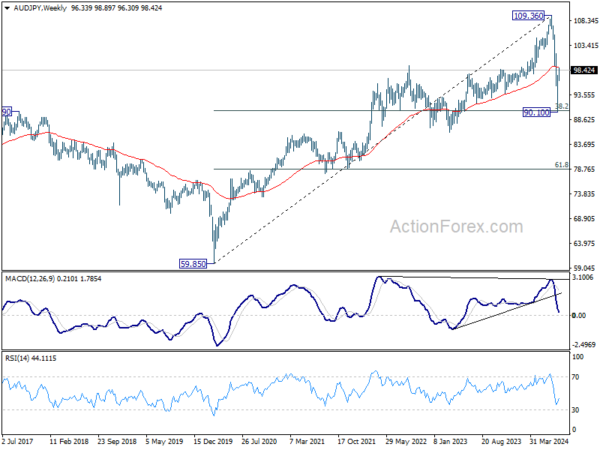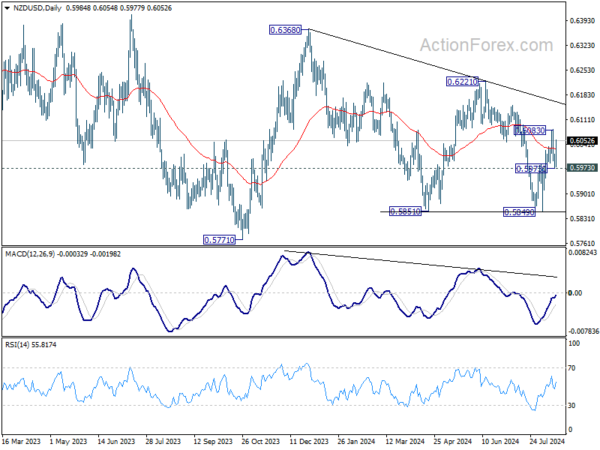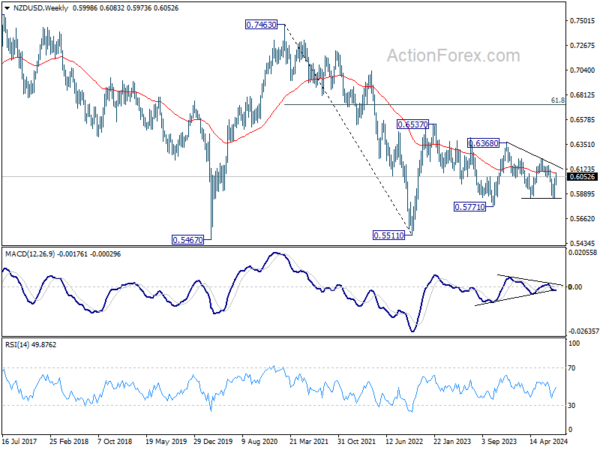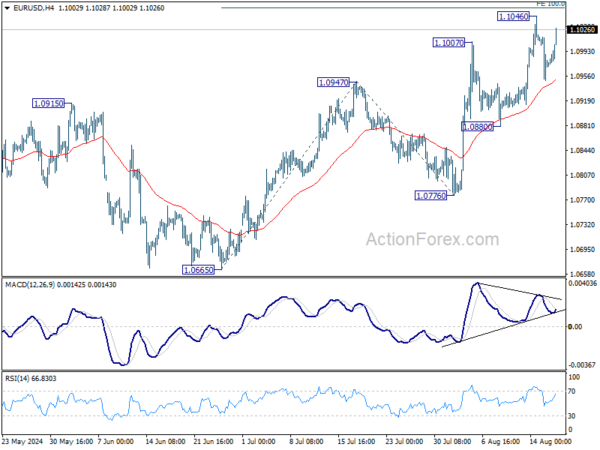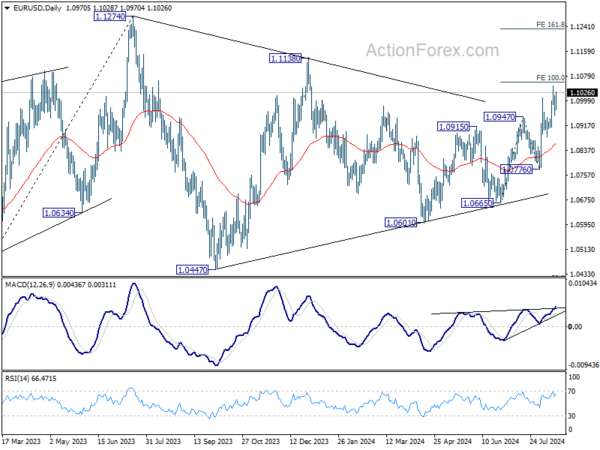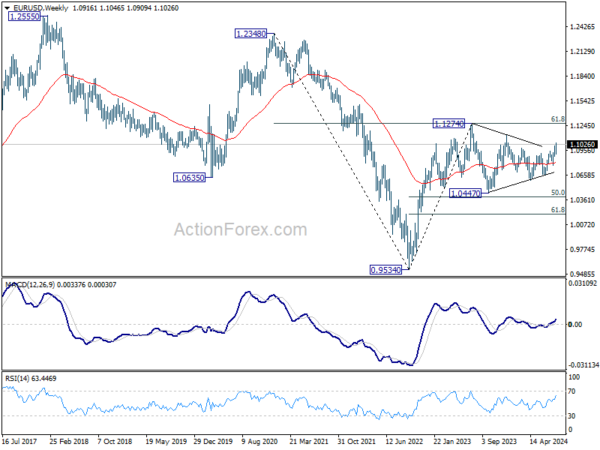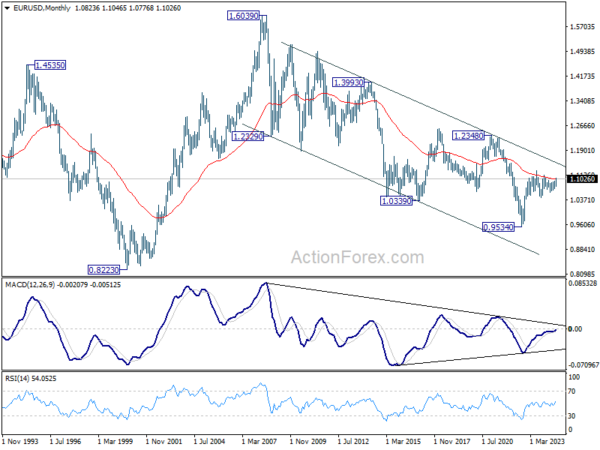Markets Roar Back As Recession Fears Fade, Safe Havens Crumble
The past few weeks highlighted the volatility of global financial markets and how quickly investor sentiment can shift. The sharp selloff in US markets, driven by fears of an impending recession, now appears significantly overdone in light of last week’s robust rebound. Strong retail sales data was a key factor in this turnaround, showing that US consumers remain resilient and continue to drive economic growth, helping to quell recession concerns. While it may be premature to expect major US indexes to resume their record runs that soon, the range for consolidations, even as medium term ones, should have been largely set.
In response to this shift in sentiment, the forex markets saw a broad retreat in safe-haven currencies. Yen took the hardest hit, followed closely by Swiss Franc and then Dollar. Conversely, Australian Dollar stood out as the star performer, buoyed not only by the global risk-on sentiment but also by strong domestic job data, which reinforced RBA’s stance on to hold off on rate cuts for the foreseeable future.
British Pound also had a strong week, ranking as the second-best performer, as a series mixed economic reports left the market uncertain about timing of BoE’s next cut. Euro rounded out the top three, supported by buying interest against Dollar, Yen, and Swiss Franc.
Meanwhile, Canadian and New Zealand Dollars ended the week in the middle of the performance pack. Notably, New Zealand Dollar showed remarkable resilience despite RBNZ’s surprise dovish rate cut.
US Markets Soars as Recession Fears Diminish, Dollar Set for Further Weakness
Last week saw a dramatic turnaround in market sentiment in the US, with S&P 500 posting an impressive 3.9% gain, its best weekly performance in 2024. NASDAQ surged even higher, with a 5.2% increase, while DOW rose by 2.9%. This wave of optimism wasn’t confined to the US alone—global markets followed suit, with Japan’s Nikkei 225 delivering an extraordinary 8.7% gain, closing over 22% higher from its previous week’s spike low.
The primary catalyst for this rally was the much stronger-than-expected US retail sales data for July. While the growth was heavily driven by auto sales—a segment known for its volatility—investors interpreted the robust consumer spending as a reassuring sign that the US economy might avoid a recession.
This optimism was further supported by the latest CPI data, which showed continued progress in disinflation. The CPI figures helped solidify Fed’s path toward starting monetary easing in September, without the need for an emergency inter-meeting rate cut or a large initial cut. Reflecting this sentiment, fed fund futures now price in only a 25% chance of a 50 basis point cut in September, down from over 55% just a week ago.
However, it’s important to remember that the situation remains fluid. There is still one more non-farm payroll report scheduled for September 6, and another CPI report on September 13, both of which could influence the Fed’s decision during its September 17-18 meeting.
DOW’s strong rally confirmed that pullback from 41376.00 has completed at 38499.27. The strong support from 38.2% retracement of 32327.20 to 41376.00 at 37919.35 suggests that price actions from 41376.00 are merely consolidation to rally from 32327.20, not a larger scale correction.
For now, another falling leg could still be seen before the consolidation pattern completes. But downside should be contained by 37919.35 fibonacci support. Another record is envisaged as the up trend resumes at a later stage.
Dollar Index struggled in range above 102.16 last week as Fed expectations were counted by risk-on sentiment. But technically, outlook will stay bearish as long as 103.65 support turned resistance holds. Break of 102.16 will resume the fall from 106.13 towards 99.57/100.61 support zone.
More importantly, further decline in Dollar Index would push it through medium term trend line support, which would argue that consolidation from 99.57 (2023 low) has completed with three waves to 106.13. Further break of 100.61 support will suggest that the down trend from 114.77 (2022 high) is ready to resume through 99.57 to 61.8% projection of 114.77 to 99.57 from 106.13 at 96.73.
The bearish scenario for the Dollar Index could gain traction if the risk-on sentiment persists, pushing US stock indexes to new record highs.
Sterling Strengthens as BoE Rate Cut Uncertain After Data
Sterling was the second best performer last week after the slew of economic data left no decisive conclusion about whether BoE would cut interest rate again in September. The uptick in July’s UK CPI was less than expected while core CPI continued slowing. However, job data was robust while Q2 GDP growth matched expectations. Retail sales in July showed strong rebound even though it missed expectations slightly.
As a result, markets are currently pricing in less than 50% chance of a rate cut in September, with the decision likely to be as closely contested as the one in August. There is a plausible scenario where the BoE might delay a rate cut until November when new economic forecasts and Q3 data are available. However, with only one more Monetary Policy Committee meeting scheduled in December, this could limit BoE to just a total of 50 bps cut this year.
GBP/USD’s strong rally last week suggests that correction from 1.3043 has completed at 1.2664 already. Rise from 1.2298 might be ready to resume through 1.3043 to 61.8% projection of 1.2298 to 1.3043 from 1.2664 at 1.3124, which is close to 1.3141 high.
More importantly, any further upside acceleration would raise the chance that GBP/USD is indeed trying to resume whole up trend 1.0351 (2022 low). That would set the stage to 38.2% projection of 1.0351 to 1.3141 from 1.2298 at 1.3364 next.
Aussie Leads the Pack as Risk-On Sentiment Boosts Markets, Kiwi Shows Resilience Post-RBNZ Cut
Australian Dollar stood out as the strongest performer in the currency markets last week, driven by a combination of renewed risk-on sentiment and surprisingly robust domestic job data. Additionally, RBA has maintained a clear stance against any imminent rate cuts, which further supported the Aussie’s strength. Unless there is an unexpected U-turn similar to the recent surprise from RBNZ, the earliest realistic time for RBA to consider a rate cut is February 2025.
Speaking of New Zealand, Kiwi displayed remarkable resilience despite RBNZ’s unexpected rate cut. Although the Kiwi lost ground against the Euro, Sterling, and Aussie, it managed to hold its own against other major currencies. RBNZ’s new economic projections were notably dovish, with significant downgrades in Q2 and Q3 growth forecasts, making another rate cut this year almost certain. The key debate now is whether RBNZ will move to cut rates at both of its remaining meetings this year or opt for just one.
Technically, AUD/JPY’s extended rebound last week and break of 38.2% retracement of 109.36 to 90.10 at 97.45 suggests that fall from 109.36 has completed at 90.10 already. Further rise is now in favor as long as 96.75 support holds, to 61.8% retracement at 102.22. However, as current rebound is seen as the second leg of the medium term corrective pattern from 109.36, strong resistance could emerge around 102.22 to limit upside.
NZD/USD’s post RBNZ retreat was rather brief as it quickly rebounded after hitting 0.5973. Further rally is now expected as long as 0.5973 support holds, and break of 0.6083 will target trend line resistance (now at around 0.6164). For now, it’s too early to decide whether NZD/USD is ready to breakout from the converging range pattern that started back in 2022 at 0.5511. So, beware of strong resistance from the falling trend line to limit upside.
EUR/USD retreated after edging higher to 1.1046 last week but stayed in range above 1.0880 support. Initial bias remains neutral this week for consolidations, and further rally is in favor. On the upside, firm break of 100% projection of 1.0665 to 1.0947 from 1.0776 at 1.1058 could prompt upside acceleration through 1.1138 resistance to 161.8% projection at 1.1232. However, considering bearish divergence condition in 4H MACD, break of 1.0880 will suggest near term reversal and turn bias to the downside for 1.0776 support and below.
In the bigger picture, price actions from 1.1274 are viewed as a corrective pattern that’s could still extend. Break of 1.1138 resistance will be the first signal that rise from 0.9534 (2022 low) is ready to resume through 1.1274 (2023 high). However, break of 1.0776 support will extend the correction with another falling leg back towards 1.0447 support.
In the long term picture, a long term bottom is in place at 0.9534 (2022 low). Sustained break of 55 M EMA (now at 1.1012) will raise the chance of long term reversal. But even in this case, firm break of 1.2348 structural resistance is needed to confirm. Rejection by 55 M EMA will maintain bearishness for extend the down trend from 1.6039 (2008 high) through 0.9534 at a later stage.
The Penny Drops: Understanding The Complex World Of Small Stock Machinations
Micro-cap stocks, often overlooked by mainstream investors, have recently garnered significant attention due to rising c... Read more
Current Economic Indicators And Consumer Behavior
Consumer spending is a crucial driver of economic growth, accounting for a significant portion of the US GDP. Recently, ... Read more
Skepticism Surrounds Trump's Dollar Devaluation Proposal
Investors and analysts remain skeptical of former President Trump's dollar devaluation plan, citing tax cuts and tariffs... Read more
Financial Markets In Flux After Biden's Exit From Presidential Race
Re-evaluation of ‘Trump trades’ leads to market volatility and strategic shifts.The unexpected withdrawal of Joe Bid... Read more
British Pound Poised For Continued Gains As Wall Street Banks Increase Bets
The British pound is poised for continued gains, with Wall Street banks increasing their bets on sterling's strength. Th... Read more
China's PBoC Cuts Short-Term Rates To Stimulate Economy
In a move to support economic growth, the People's Bank of China (PBoC) has cut its main short-term policy rate for the ... Read more


